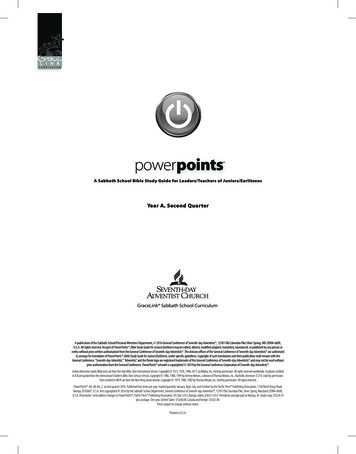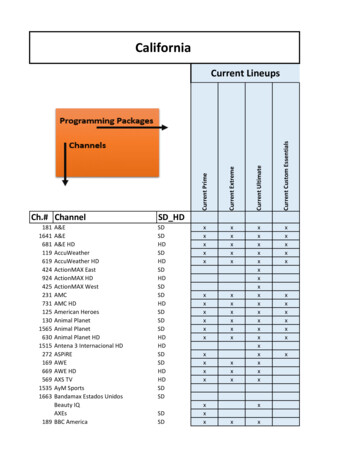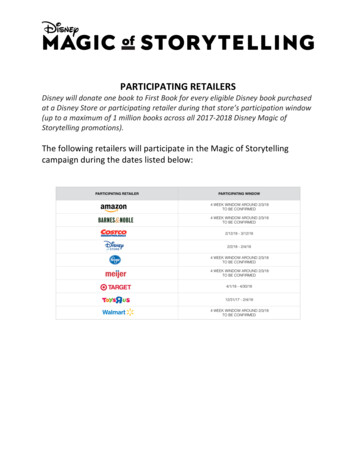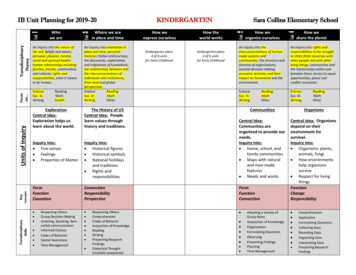
Transcription
THE DISNEY INFLUENCE ON KINDERGARTEN GIRLS’ BODY IMAGETanawan Asawarachan, B.Ed., M.Ed.Dissertation Prepared for the Degree ofDOCTOR OF EDUCATIONUNIVERSITY OF NORTH TEXASMay 2013APPROVED:George S. Morrison, Major ProfessorHarry Benshoff, Committee MemberCarol Hagen, Committee MemberAnne Rinn, Committee MemberNancy Nelson, Chair of the Department ofTeacher Education and AdministrationJerry R. Thomas, Dean of the College ofEducationMark Wardell, Dean of the Toulouse GraduateSchool
Asawarachan, Tanawan. The Disney Influence on Kindergarten Girls’ Body Image. Doctorof Education (Early Childhood Education), May 2013, 105 pp., 14 tables, reference list, 167titles.Media is now a part of the early childhood world. In many countries, includingindustrialized and developing countries, children spend more time consuming various kinds ofmedia. The impact of media on children’s perception of their body images has been andcontinues to be a concern of parents and early childhood professionals.This research examined the influence of Disney movies on Thai kindergarten girls’ bodyimages and self-esteem. Thai kindergarten girls completed three measures of body self-image:the Body Figure Preference Scale, the Body Esteem Scale, and the Self-Esteem Scale. The girlparticipants were randomly assigned to two groups: focused on a female theme (FFT) andfocused on a non-human theme (FNT). The experimental group viewed “female” Disney moviethemes, while the control group viewed “animal” Disney movie themes.Girls in the experimental group expressed greater body image dissatisfaction scoresafter watching Disney movies, which was an expected finding. Results from the present studysuggest that girls in both groups become concerned about their body esteem after videoexposure. However, there was no significant difference in self-esteem between girls in FFT andFNT. In summary, the findings of this study support the belief that Disney movies influenceyoung girls’ perceptions of their body image, and they have an awareness of their body size. Itcan be concluded that Disney movies have an influence on Thai girls’ body image dissatisfactionand body esteem. The results also indicated that Thai girls are not totally aware of the influenceof Disney media on their self-esteem.
Understanding how Disney movies, in particular, and other media, in general, influenceyoung children, especially girls, can encourage parents and educators to identify risk factorsassociated with children’s body image dissatisfaction and low self-esteem.
Copyright 2013byTanawan Asawarachanii
ACKNOWLEDGEMENTSI would like to extend acknowledge all the people whose help and support me to finishthis dissertation. First, I would like to thank my major professor, Dr. George Morrison whoprovides and encourages me to freely explore my doctoral program to the last moment of mydissertation. Thank you for feeling confident about my ability.Next, I also would like to thank all of my committee members: Dr. Carol Hagen, Dr. AnneRinn, and Dr. Harry Benshoff. All of them gave me their warm words, sincere friendships, andknowledgeable feedback during the dissertation process. I really appreciate their advice andsupport throughout this process.Most importantly, this dissertation would not have been possible without my family andfriends. I wish to thank my dad, mom, and grand mom. I admire your loyalty, kindness,generosity, and warmth. All of you have been my greatest supporter and confident. Thank youso much for everything you have given me. I love you all with my heart.This dissertation is not mine but also theirs because I could not have done it withoutthem.iii
TABLE OF CONTENTSPageACKNOWLEDGEMENTS .iiiLIST OF TABLES .vTHE DISNEY INFLUENCE ON KINDERGARTEN GIRLS’ BODY IMAGE . 1Introduction . 1Methods . 12Results 20Discussion. 36References . 45AppendicesA.EXTENDED LITERATURE REVIEW . 55B.DETAILED METHODOLOGY . 76C.COMPLETE/UNABRIDGED RESULTS . 79D.OTHER ADDITIONAL MATERIALS . 82COMPREHENSIVE REFERENCE LIST . 83iv
LIST OF TABLESPage1Mean Score Selections and Standard Deviations for Pre-Video Condition DiscrepancyIndex Scores 242Mean Score Selections and Standard Deviations for Post-Video Condition DiscrepancyIndex Scores 253Paired t-Test Comparing the Total Scores between Groups (between Pretest andPosttest) 264ANOVA Comparing Differences Using Body Figure Preference Scale by Groups .265Descriptive Statistics for Body-Esteem Scale for the Focused on a Female ThemeGroup .286Descriptive Statistics for Body Esteem Scale for the Focused on a Non-Human ThemeGroup .287t-Test between Focused on a Female Theme and Focused on a Non-Human Theme .288Mean Levels of Self-Esteem (with Standard Deviations) and t-Test .289Distribution of Text Units for Question 4 .3110Sample of Responses for Interview Question 5, Category Concerned about OwnBody 3211Sample of Responses for Interview Question 4, Category Not Concerned about OwnBody 3412Distribution of Text Units for Question 5 .3513Sample of Responses for Interview Question 5, Category the Thin-Ideal .36C1Summary of Demographic Variables for Participants .80v
THE DISNEY INFLUENCE ON KINDERGARTEN GIRLS’ BODY IMAGEIntroductionMedia is now a part of the early childhood world. In many countries, includingindustrialized and developing countries, children spend more time consuming various kinds ofmedia. Over the last century, the films of Walt Disney have identified as a type of earlychildhood. Giroux (1995) mentioned that Disney films influence children’s role models andvalues more than conventional forms of learning such as public schools, religious institutes, andfamily. Many people accept Disney as a form of family entertainment because Disney has beenrelated to innocent childhood and fantasy (Giroux, 1995; Wasko, 2001). Disney charactersuphold the stereotype of “what is beautiful is good” (Bazzini, Curtin, Joslin, Regan & Martz,2010). For example, books and television for children usually present the heroic prince andprincess as moral and attractive, but the wicked witch and evil characters as unattractive.Myers (2002) noted that children will learn from the movies that Snow White and Cinderellaare attractive and compassionate, while the witch and the step-sisters are unattractive and evil.The impact of media on children and their body-image perspectives has increased overthe years. The effects of exposure to media images are complicated to measure. As mediainfluence on women’s body image and body dissatisfaction, the sample of women in researchstudies is limited. Many studies investigating the influence of media exposure on individuals’body image and body dissatisfaction are taken by late teenagers who are at the university level.Recent studies propose that girls as young as 6 years old face body dissatisfaction (Dittmar,Halliwell, & Ive, 2006; Dohnt & Tiggemann, 2004). There are more studies that show thatschool-aged children value the importance of being thin and have a negative statistically1
opinion about being fat. In addition, school-aged children sometimes show body imagedissatisfaction.According to social learning theory (Kozak, 2000), children might learn something abouttheir body image from the media. Boys and girls in Grade 1-3 showed a positive correlationbetween eating and body concern after viewing television (Harrison, 2000). Klein and Shiffman(2005) found that in animated cartoons overweight characters are usually unattractive andunintelligent. As compared to average and underweight characters, they encounter physicaldisabilities and participate in antisocial acts. They were less likely to be happy and lucky.Obviously, they were not seen as the good guy. Sherida (2007) showed that overweightchildren felt pressure from their peers because they were not chosen to be playmates.According to Oliveira (2000), kindergarten children accurately identify themselves andtheir classmates as under, average or overweight. As media is influencing our socialization, it isimportant to analyze what children are learning about body image and body dissatisfactionfrom these movies. In general, studies demonstrate that media images play an important role inshaping body image and personality in young people more so than adults. The media portraysclear messages about the positive sides of being thin and the disadvantages of being fat(Heaton, 2010; Jefferson & Stake, 2009). Some critics have proposed that children view theseanimated films for pure entertainment and they do not take away any potential messages fromthe films (DeFife, 2009). In contrast, others commented that children tend to use popularstories and fairy tales to perceive who they are and to understand their environments (Tanner,2003).2
Therefore it is important to conduct more research on media images and their effectson body image and body dissatisfaction. To date, few studies have explored the impact ofDisney animated films on young Thai girls’ body image. The goal of this study is not to decidewhat is “bad” about the messages from the media; instead, the goal of this study is to examinewhether Disney animated films influence Thai girls’ body image and self-esteem.Body image issues have been discussed for a long time. Rice (1995) clarified that bodyimage is “an individual’s experience of his/her body. It is the mental picture a person has ofhis/her body as well as the individual’s associated thoughts, feelings, judgments, sensations,awareness and behaviors” (p. 9). The concept of ideal body image is socially and culturally builtand differs across cultures and times. It can be linked to critical physiological and psychologicalperceptions that can have serious, persistent, and even life-threatening outcomes foradolescents (Johnson, & Taylor, 2008). Body image can be measured by calculating thecontradiction between one’s silhouettes rating of his/her real self versus the ideal self. For thispaper, the researcher defined body esteem as an individuals’ feeling about his or her body andappearance. Various kinds of media also influenced individuals to examine their own bodiesand compare them to the figures they see. Herbozo, Tantleff-Dunn, Gokee, and Thompson(2004) found the result from a content analysis that Cinderella and The Little Mermaiddisplayed the most points with body imaged related themes in popular children’s videos andbooks, while Indian in the Cupboard and E.T. showed fewest body image related theme.Media today, including magazines, newspapers, television, internet, phones, iPads, ormovies, is influencing people’s lives (Johnson, & Taylor, 2008). The impact of media is massiveand the variety of media has intensified. The influences of media images and messages are3
clearly vigorous and prevalent. A number of studies demonstrate the power of media imageson girls’ perspectives about body image. The messages from media play a vital role for womenmore than for males (Damico & Fuller, 2007; Dijkstra & Barelds, 2011; Johnson, & Taylor, 2008;López-Guimera, Levine, Sánchez-Carracedo, & Fauquet, 2010; McCabe, Ricciardelli, & Ridge,2006; Wasylkiw, MacKinnon, & MacLellan, 2012). Damico and Fuller (2007) pointed out girlsrevealed media images as one of the reasons for wanting to be thin. According to McCabe,Ricciardelli, and Ridge (2006), more than 50% of the girls who participated in the studymentioned media sending negative messages about bodies, especially messages suggestingthat most of them fell short of the ideal image. Media frequently presents unrealistic,unfeasible, and impracticable images of beauty to women. Children are exposed to manysources that directly form and contribute to their intellectual, social, and emotional lives(Grogan, 2008; Veldhuis, Koniin, & Seidell, 2012). Research on Disney movies has been widespread in the last decade because of the impact on children’s lives. Many studies have shownthe negative influences of movies by measuring either children’s behaviors or responses(Grogan, 2010). The most important issue affected is body image. As Disney movies becomemore and more common and influential in today society, studies have shown that Disneymovies convince girls to be thinner and boys to be more muscular (Doran, 2009). Children tendto preserve a thin or muscular figure as ideal in movies. Herbozo, Tantleff-Dunn, Gokee-Laroseand Thompson (2004) revealed that physical appearances were connected to traits of kindness,happiness, and success in those movies. The most desirable characters were thin and muscular.In contrast, negative characters were portrayed as obese, unattractive, wicked, unkindly andbrutal. Many people believe that Disney movies play a role as a teacher of social standards,4
especially to young people (Myers, 2002). Therefore, they have potential to help children andadolescents realize that all images represented in the media are often unrealistic. Klein andShiffman (2006) commented that since the 1950s, many thin characters presented in children’smovies have increased, while overweight characters have decreased. They concluded that theinternalization of these images may contribute to body image dissatisfaction.According to some feminists’ perspectives (Kilbourne, 2005; Orenstein, 2006), Disneyprincesses represent an unhealthy life style. Every princess is too thin. Children idolizing Disneyprincesses want to be treated like and look like Disney princess, Barbie dolls, or supermodels.These effects indicate the seriousness of this topic and why it is important to continue withfurther research. Continuing research in this area may help and convey understanding of thisissue and prevent young women from body image dissatisfaction.ThailandIn Southeast Asia, Thailand is the only country to have evaded colonial rule (APCD,2003). In the Thai language, Thailand is defined as the “Land of Freedom” because the wordThai means “freedom.” Thailand is a constitutional monarchy under the king, BhumibolAdulyadej, who has reigned since 1946 (Tourism Authorities of Thailand, 2000; ThailandInformation, n.d.). According to Amato (2004), Thailand is nearly 198,114 square miles (513,120square kilometers) in Asia. It is bordered to the north by Burma and Laos, to the east by Laosand Cambodia, to the south by the Gulf of Thailand and Malaysia, and to the west by theAndaman Sea. There are 78 provinces, which are divided into six regions. The capital ofThailand is Bangkok. Ninety-five percent of the Thai population belongs to the Theravada5
branch of Buddhism. Other religions populations are Sikhs, Hindus, Christians, and Jews(Thailand Information, n.d.; Tourism Authorities of Thailand, 2000,).The family is the cornerstone of Thai society. Family life is often more closely knit thanin Western cultures. According to Amato (2004), in the past, Thai people usually live inextended families. Although everyone in the family lives in several houses, the houses areusually simple and all located on one large plot of family land. The family raises animals such asbuffaloes, chicken, etc. and keeps them below their houses, with the family living above. Thebenefit of this living style is a strong sense of family membership and tolerance (Busch, 1959).Adults in Thailand play important roles as children learn to grasp the codes of behaviorthat will lead them throughout their life (Thienchai, n.d.). Today, Thais live in a moderntechnological world and accept many Western perspectives. Family members are increasinglymore independent, especially in big cities. More specifically, parents work hard outside thehome and return home tired. They need time to rest and work, not solely raise their children.Home has become a place where members sleep only. Since becoming more westernized,parents have changed the ways they raise their children (Kamonthip, n.d.; Thienchai, n.d).Conceptualizations of Thai WomenThe conceptualization of women forms the roles of Thai women. The roles of Thaiwomen have long been established and traditionalized. Thai females usually serve ashousewives; taking care of their homes, serving their husbands and children, and managing thefamily budget. In recent years, Thai females have changed their positions because society andtechnology have changed. These reconstructions have been progressive without force fromfeminist actions. Now, more Thai women receive formal education and obtain university6
degrees. Many have served as civil servants in the administrations of the country, and somehave played a role in the economy and politics. The educational opportunity of Thai females isequal to males. Since women are getting more education, having more work opportunities, andgaining more independence both socially and financially, they have obtained more power inThai society (Kabilsingh, 1991). These are just a few reasons why Thai women’s self worth andself image have changed in recent years.Thai Animation FilmsIn East Asia, South Korea has a powerful influence on animation as well as India in SouthAsia. In Southeast Asia, Thailand’s influence is equally as powerful as Korea. In January 2004,the Thai government declared a project to build up multimedia and animation by investing abudget of about 80 billion baht (US 2 billion) to the industry (Lent, 2004). Mr. SurapongSuebwonglee, Information and Communications Technology Minister, revealed that right nowthe government has a project about animated movies. The short term goal for this animationproject is to produce animated movies by joining the private sector and the government. Thesemovies will be Thai brand name with a world-class theme. Moreover, the government willcontribute to the animated industry by forming digital content course, encouraging nearly1,000 to 25,000 people, and supporting resources for the government’s “GoodNet” project, anInternet service for learning digital content. More importantly, the Thai government alsofunded two festivals, the Thai Anima 2003 and the Thai Animation Multimedia, to support andfacilitate an interest in animation (Lent, 2004).Animation has been in Thailand since after the Second World War. Ajarn SanaeKlayklean was the first person to create animation films on television (Lent, 2004; Kamol, 2006).7
The Thai government asked him to create a short animated cartoon in an effort to direct Thaipeople to wear hats and farmers to wear boots. However, many projects by Sanae needed tobe canceled because the government had laws to control media at that time. There were manyanimation projects, such as Hanuman, or cartoons which were about corruption, or financialsupport by the United States government. However, those were banned because the Thaigovernment of Chompol Salid Tanarut did not support these kinds of animated films. In fact,most of them were about politics in Thailand. Ten years later, in 1979, Ajarn PayutNgaokrachang created the first Thai animation, Sudsakorn. This cartoon was popular and wellknown ever since it was released in Thailand on Songkran Day, April 13, 1979. In 2006, a Thailive action fantasy film, The Legend of Sudsakorn, was created. The plot of Sudsakorn is about abrave boy, Sudsakorn, who is the son of a mermaid and a minstrel prince. He fights manyanimals, such as an elephant, shark, and dragon on horse. He also battles with a king, a hermit,a yogi, a magic wand, and ghosts. Animation films in Thailand have been created and developedever since. The fact that the high cost of producing films was a major problem so Thaianimation films disappeared from Thai society (Kamol, 2006; Matichon, 2010).In 1999, Broadcast Thai Television Co., LTD, the modern Thai entertainment industry,created and produced many Thai animation cartoons (ASTV, 2006). These cartoons byBroadcast Thai Television were adapted and based on Thai traditional stories, such as Pla BuThong, Sang Thong, or Ngao Pa. Most of these Thai animation films had ethnic and moral plotlines. For example, Pla Bu Thong teaches children that the more you give, the more you getback. Pla Bu Thong, a kind of Thai fish, is used as a major character in this film. A girl, Eeay,believes that Pla Bu Thong is her mother because her father told her that her mom is under a8
river. She really loves her mom and feeds Pla Bu Thong every day. One unlucky day, her mom iskilled and Eeay prayed for her mom. Finally, she married Prince Prommatat because of hergratefulness to him (Bann Maha.com., 2009). Another famous animated feature film is KhanKluay, which was released in 2006. Khan Kluay was the first computer-animated feature film. Itwas directed by Kompin Kemgunerd who worked with Disney Company for a long time. He wasa part of Atlantis: The Lost Empire and Tarzan and Blue Sky Studio’s Ice Age. Although this filmwas done on computers, Kompin faced many of the same obstacles as Payut faced, such asfunding and human resources. The film has also been released in the United States under thename The Blue Elephant. This movie is about a baby elephant named Khan Kluay who leaves hismother and finally becomes a war elephant (ASTV, 2006; Kamol, 2006). Kompin was aprofessional animator who worked with Walt Disney and Blue Sky Studios for a long time. Hecreated and produced many Thai animation films for children. Kompin helped a team of Thaianimation innovators to win the International Animation Contest at the third annual FJORG(pronounced FORGE) computer graphic conference (ThaiTradeUSA, 2010).Compared to Disney animated films which have several decades of experience, Thaianimators are quite competent in terms of both technical skills and creative ideas (ASTV, 2006).Thai animated feature films need a variety of content across different formats and charactersso that Thai people will pay more attention to Thai animated films.Disney in ThailandThere is no evidence that indicates when and how Disney movies were introduced inThailand. Nevertheless, today Disney is influencing Thai society in many ways, such as teachingEnglish and family entertainment. Disney is popular and the animated films are still deemed9
positive for children. One reason for this positive point of view is the importance of English. InThailand, proficiency in English and experience in the United States are of greater benefit andhigher value than proficiency in other languages or experiences in other countries. Moreover,Thailand is a member of the Association of Southeast Asian Nations. The ASEAN and the Thaigovernment push Thai people to have English proficiency in order to encourage increasedinvestment and cooperation from other countries. As a result, Thai people believe that Englishis necessary for affluence in Thailand and around the world. It is not surprising that Thai parentsprovide children with Disney movies because they believe that those movies will bring goodopportunities for children to improve their English (Teaching Thailand, 2012). Therefore, Disneymovies can be educational tools as well as entertainment sources.Another reason for Disney’s popularity in Thailand is the parents’ positive encounterswith Disney. Although there is no evidence to indicate when Disney first came to Thailand, itseems Disney films have played a vital role in Thai society for a long time. Thus, parents havepositive feelings about Disney movies. Today, Disney films continue to be re-released. Childrenand grandchildren of parents and grandparents who were once children themselves whenmovies were first released continue to enjoy watching their films today. Parents think of theirown childhood memories when re-watching a Disney film (Disneythaitown.com, 2005).Ethics and morals are also important issues in Thailand. The emphases on morals inDisney films bring many Thai parents to see them as educational sources for their children.Most parents believe that Disney movies can teach children good morality and ways to be agood person. For example, Disney usually presents the bad women as unhappy, and who are10
punished by the film’s end, while the good heroine portrays kindness and compassion and isrewarded by the end (Disneythaitown.com, 2005).Disney has become so popular in Thailand (Bangkok Post, 2012) that Mr. SiddiwatCheewarattanaporn, the chairman of Association of Thai Travel Agents, or ATTA, has contactedDisney Theme Park Development Division of Walt Disney Co, to encourage the construction of aDisney Theme Park in Thailand. The current government of Prime Minister Yingluck Shinawatrais interested in this project and wants to support the investment. Mr. Siddiwat says it couldhelp stimulate the economy. In his plan, the government will invest in the construction or askthe private sector to join. A Disney Land Park will cost an estimated 20 billion baht ( 625,000).According to the report, the inexpensive cost of living in Thailand is relevant factors. Thisproject will form jobs for Thai people and facilitate investment and visitors to Thailand(Bangkok Post, 2012).Overall, whether Disney is positive or negative for children, it is still popular andinfluences children in Thailand. The Thai social, cultural, and historical backgrounds have alsoaffected Thai children’s understandings of messages from Disney animated films. In order tostudy about young Thai girls’ perceptions of body image, I chose Disney animated films for thisstudy. According to Giroux (1995), Disney films have represented and fortified childhoodconsumerism. Therefore, as a model of women’s body image, Disney films can be used as a toolto examine Thai girls’ perceptions more than any other childhood product. This study aims tofocus on a child feels the way she does about her appearance. It is interesting that there iscurrently a lack of research on the effects of Disney films on Thai children. Therefore it isimportant to examine whether exposure to media may lead young children to have negative11
changes in body satisfaction and body esteem. Understanding how Disney movies particularlyinfluence young people, especially girls, can help parents and educators indentify risk factors oflow self-esteem, and develop protective factors for young girls.MethodsThis study was designed to examine the influence of Disney movies upon Thaikindergarten girls’ body image and self-esteem. The study included a description of mixedmethodology research approach, a report of the sampling techniques used, discussion of theunits of analysis, criticized how quantitative and qualitative methods were used, and offereddefinitions of each variable of interest. Mixed methods were used to better understand ifDisney movies were observed to have an influence on body image and self-esteem. Also, amethod of descriptive statistics was used to quantitatively describe the sample data. Pairedsamples t-test, independent samples t-test, and ANOVA were conducted in response to theresearch questions.ParticipantsThis study was conducted in Thailand and randomly collected data from 50 young Thaigirls in Kindergarten Grade 2; ages 5-6. I, as a researcher selected the children of this particularage group as participants because it is about the age when negative effects of body image beginto be influenced by the media (about 6 years old) (Dohnt & Tiggemann, 2006; Valkenburg,2004). Six years of age, in particular, is a significant age for many children, especially girls. Theyseem to form important ideas about their bodies and began to show measures of bodydissatisfaction (Dohnt & Tiggemann, 2005). I recruited the participants by using simple randomsampling method. First, I posted the recruitment flyer in the school and the consent forms were12
sent to all of the girls in Kindergarten Grade 2 who were interested in this study. There were 71girls who wanted to participate but I randomly drew out only 50 girls. They were recruited fromone local government kindergarten school division in Phra Na Korn Sri Ayutthaya province,Thailand. The name of school is Anuban Phranakhon Si Ayutthaya School. The criterion forselecting the school as site was the school consists of children who come from mixed classbackgrounds in Thailand, ranging from the very wealthy to poverty and for my convenience.The recruited girls were separated into two small groups; the experimental group,focused on a female theme (FFT) and the control group, focused on a non-human theme (FNT).Prior to participation, written informed consent and a general descriptive information formwere obtained from a parent of each particip
Body image issues have been discussed for a long time. Rice (1995) clarified that body image is “an individual’s experience of his/her body. It is the mental picture a person has of his/her body as well as the individua











